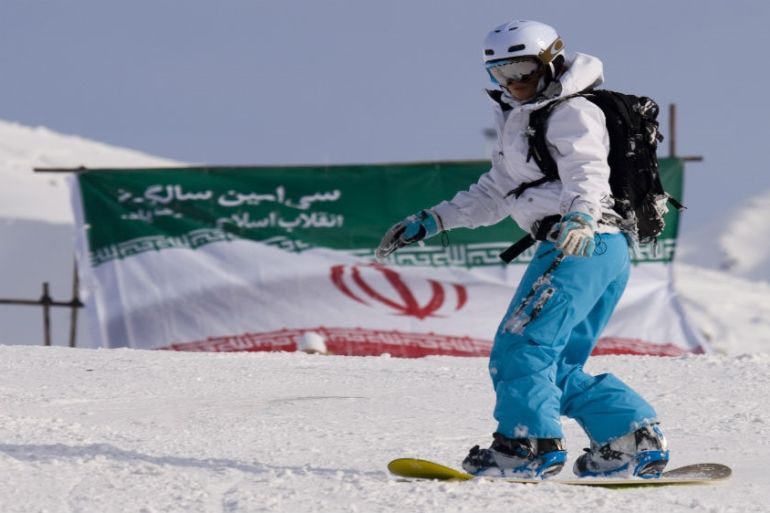Iran wants more Chinese tourists – a whole lot more
Iran is looking to Chinese tourists to boost its sanction-strapped economy. But do they want to visit?

Tehran, Iran – Fancy a stroll through the ruins of Persepolis, from which the ancient Persian kings Darius and Xerxes once ruled their empires? Or a shopping trip under the vaulted ceilings of the Tabriz souks? Or if action is more your style, how about scuba diving off Kish Island? Or snowboarding in the Alborz Mountains?
With United States economic sanctions placed on almost all of Iran’s productive sectors, the Iranian government is hoping the country’s World Heritage sites and other attractions will entice more tourists to Iran – and crucially, more hard foreign currency.
Keep reading
list of 4 itemsPhotos: Tourist numbers up in post-war Afghanistan
Malaysia’s airport fee hikes leave bad taste in travellers’ mouths
Malaysia welcomes Chinese tourists back in droves after pandemic slump
But though all tourists are welcomed, Tehran has its eye on visitors from China.
A climate for deepening ties
China and Iran already enjoy a healthy trading relationship, with Iran exporting energy to China and Chinese state enterprises making investments in Iran’s oil and gas sector.
The political climate has also grown more fertile for enhancing Iran-Chinese ties given the economic strong-arming of Tehran and Beijing by the administration of US President Donald Trump.
In a bid to attract more Chinese visitors, Iran decided in June to waive all visas for Chinese nationals, including transit visas for short stays.
In targeting Chinese visitors, Iran is looking to cultivate a lucrative and growing market. Last year, some 150 million overseas trips were made by Chinese residents, according to the United Nations World Tourism Organization.
Not only are the Chinese prolific globe-trotters, they spent over $277bn overseas in 2018, compared with just $10bn in 2000.
The pool of potential Chinese tourists is also likely to grow substantially. Currently, less than 10 percent of Chinese nationals have passports.
Lifting visa restrictions is the first step in Iran’s ambitious plan to increase the number of Chinese visitors from just over 50,000 in 2018 to two million by the end of 2020.
According to one back-of-the-envelope calculation by Esfandyar Batmanghelidj, founder of Iran-focused media website Bourse & Bazaar, if Iran does meet its lofty 2020 target and grows that number by six percent each year, the country could earn an additional $20bn by 2028 in so-called “visitor exports” – money spent by foreign tourists inside a destination country.
“It is conceivable that in the next decade, visitor exports could exceed one-fourth of oil exports (around $12 billion vs. around $45 billion),” Batmanghelidj tweeted.

First you build it…
Iran’s plan is conceivable, perhaps, but a challenge given the state of the country’s tourism sector, which suffers from weak infrastructure, low investment and lacklustre advertising.
But the government is trying to redress decades of neglect.
Plans are being drafted to construct dozens of five-star hotels around the country, funded in part by cheap government-backed loans and tax incentives for private-sector developers.
But largesse from Iran’s cash-strapped government may not be enough to accommodate the envisioned flood of Chinese tourists.
“While eliminating visa requirements will surely have a positive impact, we cannot possibly accommodate two million Chinese tourists by next year,” tourist guide Mahdieh Jahangir told Al Jazeera. “There is a shortage of five-star hotels, and establishing a large number of them would require foreign investments.”
Iran is home to a number of cultural, historical and natural attractions. It has 24 properties registered on the UNESCO World Heritage list. The ancient northern Hyrcanian Forests, home to the endangered Persian leopard, was added in July.
But Jahangir says iconic destinations alone aren’t enough to lure more visitors from China. Iran also has to change perceptions.
“I have had Chinese tourists mistaking Iran for Iraq, or thinking the country is at war, or asking whether Iranian men take four wives!” she said.
Bargain rates, thanks to the rial
Visiting Iran has become considerably cheaper for foreign travelers with Iran’s currency, the rial, losing close to 60 percent of its value since the US first announced last year that it was withdrawing from the Iran nuclear deal and reimposing sanctions
A total of 7.84 million incoming visits were lodged during the last Iranian calendar year, a massive 52.62 percent annualised jump, according to government estimates.
But last year’s sharp increase was mostly fuelled by short visits that lasted less than 24 hours and that were made by tourists from neighbouring countries who come to shop in border cities where bargains abound, thanks to the weakened rial.
By focusing on Chinese visitors, the government hopes to cultivate a less fickle source of tourist income. But unlocking it could require a different approach.
“Iran will need to move away from its current traditional model of operating tours where everything is stuffed into the tour, leaving the traveler with less options to spend on the ground,” Saeed Fekri, CEO of Kooleh Travels, told Al Jazeera.
Beyond Chinese tourists, the administration of President Hassan Rouhani is issuing more visas to neighbouring Iraqis – Iran’s most prolific visitors – and enhancing its marine tourism sector by activating several sea travel routes.
The government is also pouring more resources into medical tourism by developing health tourism hubs, especially in Shiraz, the capital of the southern Fars Province.
And a proposal to establish a national cryptocurrency is under review. That would enable easier spending by tourists by getting around the decades-long problem of obstructed access to international payment systems.
But for all the initiatives, Iran has its work cut out to win its share of the Chinese tourist market.
“For Chinese tourists, France is a dream destination,” says Jahangir, “whereas Iran remains unknown, and is hardly a first choice.”